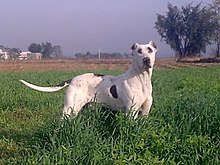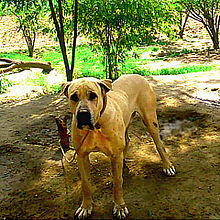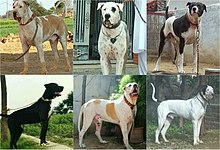Bully Kutta
| Bully Kutta | |||||||||||||||||||||||||||||||||
|---|---|---|---|---|---|---|---|---|---|---|---|---|---|---|---|---|---|---|---|---|---|---|---|---|---|---|---|---|---|---|---|---|---|
 | |||||||||||||||||||||||||||||||||
| Other names | Alangu Mastiff[1][2] Indian mastiff[1][3] Indian bully[4] Pakistani mastiff[4] Sindhi mastiff[4] | ||||||||||||||||||||||||||||||||
| Origin | Indian Subcontinent[4] | ||||||||||||||||||||||||||||||||
| |||||||||||||||||||||||||||||||||
| Dog (domestic dog) | |||||||||||||||||||||||||||||||||
The Bully Kutta[A] is a type of large dog that originated in the Indian subcontinent, dating back to the 16th century.[4][better source needed] The Bully Kutta is a working dog used for hunting and guarding. The type is popular in the Punjab region of India and Pakistan, including Haryana and Delhi, as well as in Maharashtra[5] and Tamil Nadu.[3][4][better source needed]
Name and description



Bully Kutta literally translates to "heavily wrinkled dog". The word "Bully" comes from the root word of the Hindustani and Punjabi languages "Bohli" which means heavily wrinkled.[citation needed] "Kutta" means dog in the Hindi-Urdu language.[6][7][8]
The Sindhi mastiff resembles the mastiff, and is notable for its hardiness and size. The colour is black and white with some red in places. The tail curls up and is long.[9]
History
The Bully Kutta originated in the Indian subcontinent, either in the Thanjavur and Tiruchi districts of Madras or the Sind region of medieval India.[4] In Thanjavur, the Bully Kutta was a favorite pet of ruling families.[10][page needed] The Mughal emperor Akbar owned a Bully Kutta, which he used for hunting.[11]
The Second International Dog Show at Islington Agricultural Hall, held on 28 May 1864 in London, showcased the Indian Mastiff among several other dog breeds.[12] The previous year, Edward, the Prince of Wales, and Princess Alexandra, entered an Indian Mastiff in the same show, along with a Newfoundland, Russian Tracker and two Borzois.[13][14] In 1884, Littell's Living Age said that historically, a "large Indian mastiff" was employed by kings "in the chase of wild beasts".[15]
Temperament
Bully Kuttas have been described as intelligent, alert, responsive, energetic and aggressive. A well-known veterinarian Dr. L.N. Gupta from Agra, India has stated that Bully Kuttas are a dominating canine and should only be handled by well-experienced owners.[16]
Use as a fighting dog
Bully Kuttas have been illegally used for dog fighting in India and Pakistan, including areas such as Delhi, Gurugram, and Noida.[4][17] In June 2018, police in Indian Punjab filed First Information Report (FIR) for the first time against organizers of a dog fight.[18] Many non-profit organizations are now working against illegal fighting and creating awareness among the people.[citation needed]
Popularity
The Bully Kutta is popular in the Haryana and Punjab region of India and Pakistan.[4][19] In India, breeders from Punjab, Haryana, Rajasthan, Tamilnadu and Maharashtra focusing on scientific breeding of this dog under the guidelines of Indian Mastiff Registry.[20] They have been part of many competitions in India.[21][19] According to the Times of India, it has importance among Indian youth of having a macho image.[22]
The Indian National Kennel Club, along with the Indian Mastiff Registry,[20] recognizes this breed officially.[23]
See also
References
Notes
Citations
- ^ a b c Wylde, Kaitlyn (1 August 2019). "What Dog Breeds Are Banned On Airlines? Some Dogs Can't Safely Fly On Planes". Bustle.
Indian Mastiff/
- ^ a b c d e f Deshpande, Abhijeet Madhukar (2020). Indian Dogs Pedigree Chart-The List of Indian Pedigree Dogs. p. 4.
- ^ a b c "Dog breeds that are native to India". The Times of India. 2 September 2020. Retrieved 24 September 2020.
- ^ a b c d e f g h i j Friendicoes (18 July 2017). "Meet The "Bully Kutta"". The Huffington Post. Archived from the original on 21 February 2019. Retrieved 20 February 2019.
- ^ kingsidofwestminst (2022-01-14). "REVIVING LEGACY 326 BCE to 2022". WESTMINSTER. Retrieved 2023-02-22.
- ^ Reddy, Kovuuri G. (2015). Handbook of Journalism and Media: India, Bharat, Hindustan. Vikas Publishing House. p. 136. ISBN 978-93-259-8238-3.
In Hindi, a dog is called a 'kutta'.
- ^ Romanised School Dictionary - English and Urdu Calcutta 1863, page 43
- ^ Fallon, S. W. (1879). A new Hindustani-English dictionary. E. J. Lazarus & Co. p. 908.
- ^ The Indian dog Waman Vishwanath Soman, Popular Prakashan 1963, page 85
- ^ Mani, Ajit (2018). The Nawab's Tears. Partridge Publishing. ISBN 9781543704280.
- ^ Sural, Ajay (15 Feb 2015). "Canine from Pakistan a hit in rural areas". Times of India. Retrieved 25 August 2017.
- ^ The Gardeners' Chronic and Agricultural Gazette, Volume 24. Bradbury and Evans, Printers. 1864. p. 513.
Second International Dog Show at the Agricultural Hall contains besides Foxhounds, Stag Hounds, and every variety of Dgs used in Field Sports, very fine specimens of the true English Mastiff, Indian Mastiff, Kangaroo Hounds, Boar Hounds, Bull Dogs, Terriers English and Scotch, and every kind of Toy Dog and Pet.
- ^ Hoey, Brian (2013). Pets by Royal Appointment: The Royal Family and their Animals. Biteback Publishing. ISBN 9781849546492.
Members of the royal family have been active supporters of various dog shows since Edward, the Prince of Wales, and the then Princess Alexandra entered a number of their dogs in the International Dog Show in London in 1863, when there were fifty-seven classes and over 600 entries. The support has never wavered. Among the animals Edward and Alexandra exhibited were two borzois, a Newfoundland, and Indian mastiff and a Russian retriever.
- ^ Secord, William (2009). Dog Painting: A History of the Dog in Art. Antique Collectors' Club. p. 358. ISBN 9781851495764.
He first showed at the Royal Agricultural Hall Show in 1864 when he exhibited a Newfoundland, an Indian Mastiff, a Russian Retriever and a Harrier, all of which won prizes.
- ^ Littell, Eliakim; Littell, Robert S. (1884). Littell's Living Age. T. H. Carter & Company. p. 719.
He has given a fair account of the large Indian mastiff, the same animal which the Assyrian kings employed in the chase of wild beasts; his small sheep and cattle may be even now seen in India, as in the little zebu; while his mention of a variety of iron, which, when fixed in the ground averts storms and lightnings recalls to our mind the lightning-conductor of modern days.
- ^ "Pakistani puppy penalised for traveling without ticket in Agra". Times of India. 14 January 2018.
- ^ Archit Watts (24 June 2018). "It's a dog's life". Tribune India.
- ^ "Punjab puts a leash on illegal dog fights, files first case". Times of India. 16 June 2018.
- ^ a b "Two-day livestock fair begins at Chappar Chiri". Tribune India. 26 October 2017.
- ^ a b "INDIAN MASTIFF REGISTRY". indianmastiff.org. Retrieved 2023-02-23.
- ^ "Pakistani Bully centre of attraction at animal fair in Mohali". Times of India. 26 October 2016.
- ^ Ajay Sura (16 February 2018). "Pakistani Bully in backyard boosts Punjab's macho image". Times of India.
- ^ kingsidofwestminst (2022-01-14). "INDIAN MASTIFF REGISTRY". WESTMINSTER. Retrieved 2023-02-22.
Further reading
- Baskaran, S. Theodore (2017). The Book of Indian Dogs. Aleph Book Company. ISBN 978-9384067571.
External links
- Articles with short description
- Short description is different from Wikidata
- Short description matches Wikidata
- Articles with 'species' microformats
- All articles lacking reliable references
- Articles lacking reliable references from September 2020
- All articles with unsourced statements
- Articles with unsourced statements from September 2020
- Wikipedia articles needing page number citations from September 2020
- Commons category link is on Wikidata
- Dog breeds originating in India
- Dog breeds originating in Pakistan
- Dog fighting breeds
- Hunting dogs
